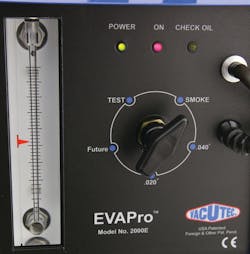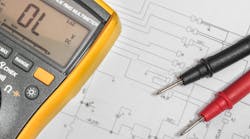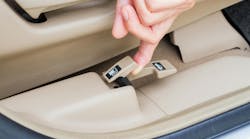Q: Toyota vehicles from 2000 to 2004 with EVAP codes have proven to be particularly challenging for many techs. When a car with one of these codes comes in, what should the tech do after the visual inspection?
A: Following visual inspection, the first step is to determine the type of EVAP system with which the vehicle is equipped, notes John Heist, OE account manager at STAR EnviroTech Inc. Between the 2000 and 2004 model years, Toyota used what are commonly referred to as the :
1) Early type (non-intrusive) system, predominately 1996 to 2000 and used sparingly 2001 to 2002.
2) Late type (intrusive) system (predominately 2001 to 2004 and used sparingly 2005 to 2006.
3) LEV-II system – standard purge and open vent system (2002 to 2004).
Once the type of system has been determined, it is then possible to perform a thorough visual inspection of all hoses, connections, and components related to the particular system under test, Heist notes.
The next step is to check for and note all diagnostic trouble codes (DTCs). A search for pertinent technical service bulletins (TSBs) at this time is very appropriate. Following this, evaluation of freeze data (that which was captured at the time the DTC set) will reveal operating conditions relevant to the code; for the experienced technician, this is typically the next diagnostic step after reviewing DTCs.
The Toyota Techstream software can also be helpful isolating a leak, notes Mike Bowdish, a senior technical support rep at Drew Technologies. Bowdish says you can run the EVAP system test in Techstream to help isolate the leak. Toyota uses a six-step process to isolate the various EVAP subsystems to help find the leak faster, he notes. The most common codes are P0441, P0442, P0446, P0451, P0452, P0453, P0455 and P0456.
Q: If there is a leak in the system, how does the tech perform a leak check? What leak tests do you begin with?
A: The presence of a leak code does not always mean there is absolutely a system leak, according to Heist at STAR Envirotech. For this reason, as with the Toyota-approved ETI2000E evaporative smoke machine, diagnostic smoke vapor machines for EVAP system testing are often equipped with a high-quality flow meter.
This component is there as an aid in diagnosing the presence of leakage before moving on to the next step of locating revealed leakage with the aid of visible vapor. For the systems in the model years listed above, to determine the presence of a leak:
1) Connect the diagnostic smoke vapor machine to the EVAP emission system as per manufacturer’s instructions. For example, a typical Toyota EVAP service port has Toyota’s specific instruction label affixed; there are instructions on both sides of the label.
2) Start the machine and observe flow into and through the EVAP system. The ball on the flow meter should be at the very top of the meter, indicating good flow through the system. The vapor fills the system and exits the air drain hose.
3) Seal the EVAP system.
a) Pinch off the air drain hose on the early and/or late types to seal the system. Some systems have the atmospheric vent connected to a plastic tee at the air drain. If so equipped, the hose should be removed and the air drain side should be sealed with a rubber vacuum cap. This allows the vapor pressure sensor to breathe and if it has a small leak, smoke will exit this hose. Otherwise, the smoke will just circulate in the system and no leak will be detected.
b) Close the vent valve on the LEV-II system using the appropriate scan tool with bi-directional control, or by other manual means.
4) With the system now sealed, observe the flow meter ball. Once the system flow has stabilized, if the ball is resting at the bottom of the flow meter, there is no flow through the system and therefore leakage is not sufficient to trigger related leak DTCs on the system in its present state, Heist notes. If, at this point, the ball is suspended anywhere in the flow meter range, there is flow through the system and leakage may be sufficient to trigger related leak DTCs. Once it has been determined that existence of leakage is present, inspect the system appropriately to locate system leak point(s) by virtue of the presence of visible vapor.
Various solutions have been offered to detect very small leaks, such as closing the EVAP vent solenoid and charge the system with CO2, notes Bernie Thompson, president of Automotive Test Solutions. In the system Thompson offers, the Bullseye Leak Detector, the flow gauge is divided into colors that show the size of the leak in the system.
Zachary Parker, president of Redline Detection LLC, notes that once the EVAP system has been pressurized, the flow meter will show the flow slowing down or stopping as the pressure equalizes with the smoke machine pressure of just under 1/2 psi. Experienced techs know that only a decay gauge that shows no leak down is 100 percent proof of a sealed system with no leaks.
A flow meter with the float ball seemingly on the bottom may be allowing some air passage (a slight decay can be observed if there will be an irregular heartbeat of the flow meter indicating there is still a “very” small leak), notes Rick Escalambre, an automotive technology instructor at Skyline College in San Bruno, Calif.
Jason Smith, an educator at Consultants for Automotive Repair Services in San Clemente, Calif., notes that smoke testers have upgraded and increased the accuracy of their flow meters, although technicians should know that this is only a guide and not an absolute when doing EVAP leak diagnosis, especially on a .020” leak.
Compressed, shop air usually comes with a high moisture content, Smith said. This shop air mixed with a thick smoke solution will weigh a lot more than fuel vapor and will not escape a leak as fast as the vapor will. Therefore, it can be hard to gauge whether the leak on the flow meter will be the same size as the one that the vehicle EVAP system will pick up. It’s up to the technician to discern if what they are looking at is accurate.


